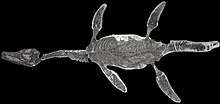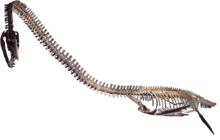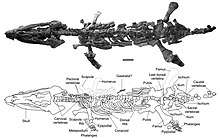Microcleidus
Microcleidus is an extinct genus of sauropterygian reptile belonging to the Plesiosauroidea. It was about the size of a medium-sized dolphin, reaching a length of 3 metres (9.8 ft). The species has 40 neck vertebrae and a short tail of 28 vertebrae. Fossils of the genus have been found in France, the Posidonia Shale in Germany and the Alum Shale Formation of England.
| Microcleidus | |
|---|---|
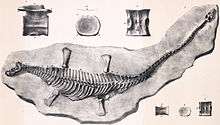 | |
| Fossil M. homalospondylus | |
| Scientific classification | |
| Kingdom: | Animalia |
| Phylum: | Chordata |
| Class: | Reptilia |
| Superorder: | †Sauropterygia |
| Order: | †Plesiosauria |
| Family: | †Microcleididae |
| Genus: | †Microcleidus Watson, 1909 |
| Type species | |
| Plesiosaurus homalospondylus (Owen, 1865) | |
| Other species | |
| |
| Synonyms | |
|
M. macropteus
M. tournemirensis
| |
Classification

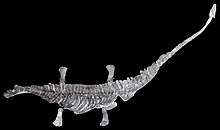
.jpg)
Species include: Microcleidus homalospondylus (Owen 1865) and Microcleidus macropterus (Seeley 1865).
Occitanosaurus tournemirensis (originally "Plesiosaurus" tournemirensis), was named by Sciau et al. in 1990, based on a nearly complete skeleton of an animal approximately 4 meters (13 ft) long.[1] It was later found to be a species of Microcleidus.
The following cladogram follows an analysis by Ketchum & Benson, 2011.[2]
References
- Ketchum HF, Benson RBJ. Global interrelationships of Plesiosaur (Reptilia, Sauropterygia) and the pivotal role of taxon sampling in determining the outcome of phylogenetic analyses. Biological Reviews
- Hilary F. Ketchum and Roger B. J. Benson (2011). "A new pliosaurid (Sauropterygia, Plesiosauria) from the Oxford Clay Formation (Middle Jurassic, Callovian) of England: evidence for a gracile, longirostrine grade of Early-Middle Jurassic pliosaurids". Special Papers in Palaeontology. 86: 109–129. doi:10.1111/j.1475-4983.2011.01083.x (inactive 2020-01-22).CS1 maint: uses authors parameter (link)
Bibliography
- Bardet, Nathalie; Fernandez, Marta; Garcia-Ramos, Jose Carlos; Superbiola, Xabier Pereda; Pinuela, Laura; Ruiz-Omenaca, Jose Ignacio; and Vincent, Peggy (2008). "A juvenile plesiosaur from the Pliensbackian (Lower Jurassic) of Asturias, Spain". Journal of Vertebrate Paleontology 28(1): 258–263
- Plesiosaur.com 13 Oct 2006
- Palæos.com 13 Oct 2006
